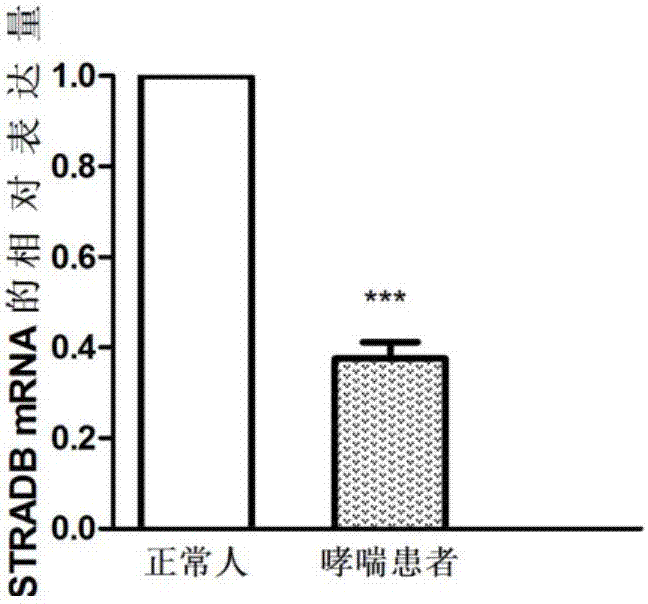Application of STRADB to early diagnosis of asthma
An asthma and genetic technology, applied in the field of biomedicine, can solve the problems of difficult detection of asthma and easy misdiagnosis.
- Summary
- Abstract
- Description
- Claims
- Application Information
AI Technical Summary
Problems solved by technology
Method used
Image
Examples
Embodiment 1
[0064] Example 1 Screening Gene Markers Related to Asthma
[0065] 1. Sample collection
[0066] According to the diagnostic criteria of the guidelines for the diagnosis and prevention of bronchial asthma, 3ml of peripheral venous blood was collected from 10 cases of normal people and blood from asthmatic patients. The patients gave informed consent, and all the above samples were obtained with the consent of the ethics committee.
[0067] 2. RNA sample preparation and quality analysis
[0068] 2.1 Preparation of RNA samples
[0069] Total RNA was extracted using the RNA extraction kit from Promega. Specific steps are as follows:
[0070] 1) Take 1ml of whole blood collected in a test tube treated with heparin or EDTA, and put it into a sterile centrifuge tube;
[0071] 2) Centrifuge at 3000rpm (400g) for 5min, carefully suck off the supernatant from the top of the sample;
[0072] 3) Add 1ml of blood cell lysate, pipette carefully 4-5 times, resuspend the sediment, and c...
Embodiment 2
[0095] Example 2 QPCR sequencing to verify the differential expression of the STRADB gene
[0096] 1. According to the detection results of high-throughput sequencing, the STRADB gene was selected for large-sample QPCR verification. According to the method in Example 1, 80 blood samples from asthma patients and 80 normal people were collected and selected.
[0097] 2. The RNA extraction steps are the same as in Example 1.
[0098] 3. Reverse transcription: use the reverse transcription kit of TAKARA company to operate. Specific steps are as follows:
[0099] (1) Take 2 μg of total RNA for reverse transcription, add 2 μl of Oligo(dT), and mix well; immediately after 5 minutes in water bath at 70°C, ice bath for 2-3 minutes;
[0100] (2) Construct a 25 μl reaction system, including 5 μl of 5× reverse transcription buffer, 5 μl of dNTP (2.5 mM), 40 U / μl of RNasin, 200 U / μl of M-MLV, and make up to 25 μl of nuclease-free water;
[0101] (3) After 42°C water bath for 60 minutes...
Embodiment 3
[0111] Example 3 Protein level verification of differential expression of STRADB
[0112] 1. Extract each histone according to the instructions of the RIPA protein lysate kit, and use the BCA protein concentration assay kit to detect the protein concentration in the sample.
[0113] 2. The changes of STRADB protein were detected by conventional Western-blot method. The experiments in each group were repeated 3 times, and β-actin was used as an internal reference to perform quantitative analysis of the absorbance of the STRADB protein band. The expression level was represented by the ratio of STRADB protein / β-actin absorbance .
[0114] 3. Results
[0115] The result is as figure 2As shown, compared with normal people, the protein level of STRADB in asthmatic patients was significantly down-regulated, and the difference was statistically significant (P<0.05).
PUM
 Login to View More
Login to View More Abstract
Description
Claims
Application Information
 Login to View More
Login to View More - R&D
- Intellectual Property
- Life Sciences
- Materials
- Tech Scout
- Unparalleled Data Quality
- Higher Quality Content
- 60% Fewer Hallucinations
Browse by: Latest US Patents, China's latest patents, Technical Efficacy Thesaurus, Application Domain, Technology Topic, Popular Technical Reports.
© 2025 PatSnap. All rights reserved.Legal|Privacy policy|Modern Slavery Act Transparency Statement|Sitemap|About US| Contact US: help@patsnap.com


